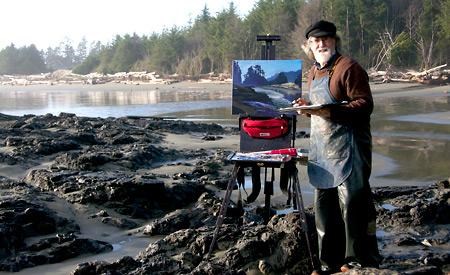An artistic movement to conserve a pristine rainforest will hold an opening for its exhibit Art for an Oil- Free Coast on November 27 in Vancouver. Works from Megan Dulcie Dill and April White, two Powell River artists, are included in the show of 50 Canadian artists.
Organizers hope the show will raise public awareness of “one of the most dramatic, beautiful and fragile places on the planet.” The exhibit is not simply a gallery of paintings. It also includes a film and book showcasing dozens of British Columbia’s most talented and acclaimed visual artists. The film, called Reflections: Art for an Oil-Free Coast, was presented at Vancouver International Film Festival and documented the artists’ expedition to the Great Bear Rainforest.
Last June Mark Hobson and the Raincoast Conservation Foundation brought the artists to the rainforest to give them the experience of the land and let them depict the rich biodiversity and integrated ecological elements in the forest, intertidal and ocean zones and wildlife.
The art-for-conservation project was the brainchild of artist and biologist Hobson, who organized a similar project in 1989 to raise awareness about Carmanah Valley on Vancouver Island. Hobson currently calls Tofino, BC home, but lived in Powell River as a child. He describes the experiences of childhood as formative and the reason for his deep love for the coast.
“Many feel as I do,” said Hobson. “It will only be a matter of time before incidents like the Exxon Valdez oil spill repeat themselves.”
The goal of the exhibit is to stimulate discussion about the proposed Northern Gateway pipeline in Kitimat, BC. Environmentalists are concerned that the proposed oil pipeline threatens the ecology of BC’s coastline in what is known as the Great Bear Rainforest. The area is extremely rugged with narrow rocky channels, inlets, islands and fjords. Great Bear Rainforest is home to an abundance of life from 1,000-year-old cedars and 300-foot Sitka spruce, to whales and dolphins, to cougars, wolves and grizzly bears, plus the Kermode “Spirit” bear, a subspecies of black bear with a white coat instead of brown.
The project brought 50 artists from across BC to Bella Bella and then took them on a five-hour boat trip north to the first nations village of Klemtu, midway up the coastline of the Great Bear Rainforest. Artists travelled in three groups of about 15. Each group of artists alternated their time between being in the village and being aboard The Achiever, the foundation’s 70-foot steel hulled sloop used for research.
“It was an incredible experience,” said Dulcie Dill. “The people there are very passionate about the pipeline and it was an amazing energy creatively.”
The book called Canada’s Raincoast at Risk is a 160-page book of original art pieces from the artists who travelled in the expedition and includes some of Canada’s most well-known artists like Robert Bateman and Roy Henry Vickers. It also includes essays and poetry. David Suzuki wrote the foreword to the book and Wade Davis the afterword.
The book is currently only available for sale online through the foundation’s website or at the Victoria Public Library, but will soon be available at Breakwater Books and Coffee in Powell River.
The exhibit will travel to Victoria and then to Salt Spring Island. Organizers are planning on taking the exhibit across Canada and through the United States.



